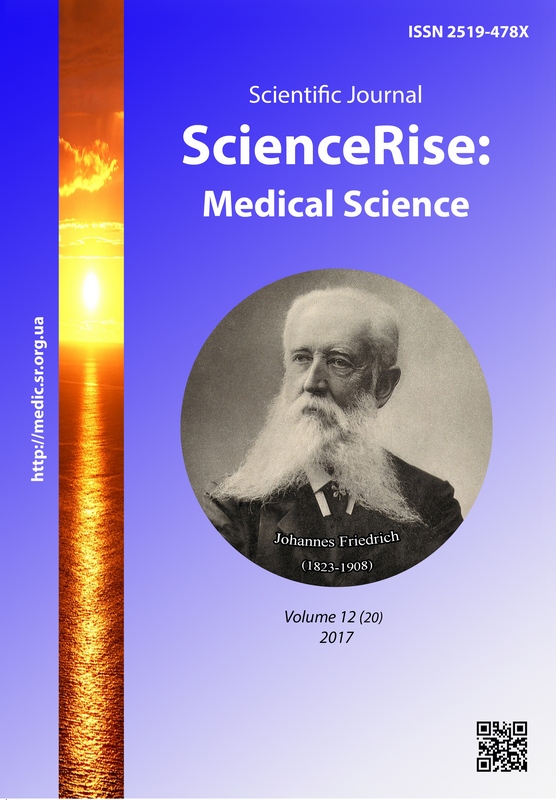Pulse pressure classes and clinical features of patients at the annual stage of medical therapy after permanent pacing
DOI:
https://doi.org/10.15587/2519-4798.2017.119946Keywords:
УДК, 616.12-008.3, 616-08-06, 615.036.8.Abstract
The aim of study was to assess the changes of patient’s clinical signs in pulse pressure classes at the annual stage after pacemaker implantation and drug therapy.
Methods. It is included 220 patients at the annual stage of the drug therapy after pacemaker implantation divided in pulse pressure (PP) classes (I - very low PP - less than 20 mmHg, II - low more than 20 - less than 40 mmHg, III - the norm - 40 - 60 mmHg, IV - high more than 60 - less than 80 mmHg, very high PP - more than 80 mmHg). We evaluated the frequencies of occurrence of the postinfarction cardiosclerosis, functional classes (FC) of stable angina; stages and severity of arterial hypertension; diabetes mellitus, forms of atrial fibrillation; FC and stages of chronic heart failure (CHF). Student's t-test was used.
Results. It is necessary to strengthen antihypertensive therapy of patients with implanted pacemakers, especially in IV and V PP classes.
Conclusion. At the annual stage after pacemaker implantation drug therapy helps to reduce the frequency of clinical signs of patients in low and high PP classes, accompanied by their concentration in III PP class
References
- Selvaraj, S., Steg, P. G., Elbez, Y., Sorbets, E., Feldman, L. J., Eagle, K. A. et. al. (2016). Pulse Pressure and Risk for Cardiovascular Events in Patients With Atherothrombosis. Journal of the American College of Cardiology, 67 (4), 392–403. doi: 10.1016/j.jacc.2015.10.084
- Walton, M. K., Powers, J. H., Hobart, J., Patrick, D., Marquis, P., Vamvakas, S. et. al. (2015). Clinical Outcome Assessments: Conceptual Foundation-Report of the ISPOR Clinical Outcomes Assessment – Emerging Good Practices for Outcomes Research Task Force. Value in Health, 18 (6), 741–752. doi: 10.1016/j.jval.2015.09.2863
- Brignole, M., Auricchio, A., Baron-Esquivias, G. et. al. (2013). 2013 ESC Guidelines on cardiac pacing and cardiac resynchronization therapy. European Heart Journal, 34 (29), 2281–2329. doi: 10.1093/eurheartj/eht150
- Kohno, R., Abe, H., Nakajima, H., Hayashi, K., Oginosawa, Y., Benditt, D. G. (2016). Effects of right ventricular pacing sites on blood pressure variation in upright posture: a comparison of septal vs. apical pacing sites. Europace, 18 (7), 1023–1029. doi: 10.1093/europace/euv298
- Yang, H., Zhang, F., Peng, X., Zhao, D., Peng, J. (2014). Efficacy of Medication Directed by Home-Monitoring Cardiac Resynchronization Therapy in Chronic Heart Failure Patients. Chinese Medical Sciences Journal, 29 (1), 61–62. doi: 10.1016/s1001-9294(14)60028-6
- Ellims, A. H., Mariani, J. A., Schlaich, M. P. (2013). Restoration of blood pressure control with pacemaker implantation in a patient with bradycardia and resistant hypertension: A case report. International Journal of Cardiology, 167 (2), e38–e40. doi: 10.1016/j.ijcard.2013.03.080
- Fihn, S. D., Gardin, J. M., Abrams, J., Berra, K., Blankenship, J. C., Dallas, A. P. et. al. (2012). 2012 ACCF/AHA/ACP/AATS/PCNA/SCAI/STS Guideline for the Diagnosis and Management of Patients With Stable Ischemic Heart Disease. Journal of the American College of Cardiology, 60 (24), e44–e164. doi: 10.1016/j.jacc.2012.07.013
- Kovalenko, V. M., Lutaia, M. I., Sirenko, Yu. M. (Eds.) (2007). Sertsevo-sudynni zakhvoriuvannia. Klasyfikatsiya, standarty diahnostyky ta likuvannia kardiolohichnykh khvorykh. Kyiv: PP VMB, 128.
- Mancia, G., Fagard, R., Narkiewicz, K., Redón, J., Zanchetti, A., Böhm, M. et. al. (2013). 2013 ESH/ESC Guidelines for the management of arterial hypertension. Journal of Hypertension, 31 (7), 1281–1357. doi: 10.1097/01.hjh.0000431740.32696.cc
- Voronkov, L. H., Amosova, K. M., Bahriy, A. E. et. al. (2013). Rekomendatsiy z diahnostyky ta likuvannia khronichnoi sertsevoi nedostatnosti Asotsiatsiy kardiolohiv Ukrainy ta Ukrainskoi asotsiatsiy fakhivtsiv iz sertsevoi nedostatnosti. Ukrainskyi kardiolohichnyi zhurnal, 6–44.
- January, C. T., Wann, L. S., Alpert, J. S., Calkins, H., Cigarroa, J. E., Cleveland, J. C. et. al. (2014). 2014 AHA/ACC/HRS Guideline for the Management of Patients With Atrial Fibrillation: Executive Summary: A Report of the American College of Cardiology/American Heart Association Task Force on Practice Guidelines and the Heart Rhythm Society. Circulation, 130 (23), 2071–2104. doi: 10.1161/cir.0000000000000040
- Mal'tseva, M. S. (2015). Klass prodolzhitel'nosti intervala QT i effektivnost' vrachebnoy podderzhki patsiyentov v perviy god implantatsii elektrokardiostimulyatora [QTc interval duration class and medical support effectiveness of patients in first year after pacemaker implantation]. Yale Review of Education and Science, 1 (16), 552–558.
- Kolomytseva, I. M., Volkov, D. Ye., Lopin, D. O., Yabluchanskiy, M. I. (2015). Funktsionalniy klas khronichnoi sertsevoi nedostatnosti ta osnovni sertsevo-sudynni stany u patsiyentiv iz implantovanymy elektrokardiostymuliatoramy na richnomu etapi aparatnoy i medykamentoznoy optymizatsiy [Functional class of heart failure and major cardiovascular conditions in patients with implanted pacemakers for one year term under proper medication]. Aktualni problemy suchasnoy medytsyny: visnyk Ukrainskoi medychnoi stomatolohichnoi akademiy, 15 (3 (51)), 136–140.
- Shanina, I. V. (2014). Klass prodolzhitel'nosti kompleksa QRS i klinicheskie osobennosti patsientov s postoyannoy elektrokardiostimulyatsiey. Ukrainskyi kardiolohichnyi zhurnal. Dodatok. Materily 15 natsionalnoho konhresu kardiolohiv Ukrainy, 4, 188–189.
Downloads
Published
How to Cite
Issue
Section
License
Copyright (c) 2017 Maryna Pochynska, Mykola Yabluchanskyi

This work is licensed under a Creative Commons Attribution 4.0 International License.
Our journal abides by the Creative Commons CC BY copyright rights and permissions for open access journals.
Authors, who are published in this journal, agree to the following conditions:
1. The authors reserve the right to authorship of the work and pass the first publication right of this work to the journal under the terms of a Creative Commons CC BY, which allows others to freely distribute the published research with the obligatory reference to the authors of the original work and the first publication of the work in this journal.
2. The authors have the right to conclude separate supplement agreements that relate to non-exclusive work distribution in the form in which it has been published by the journal (for example, to upload the work to the online storage of the journal or publish it as part of a monograph), provided that the reference to the first publication of the work in this journal is included.









